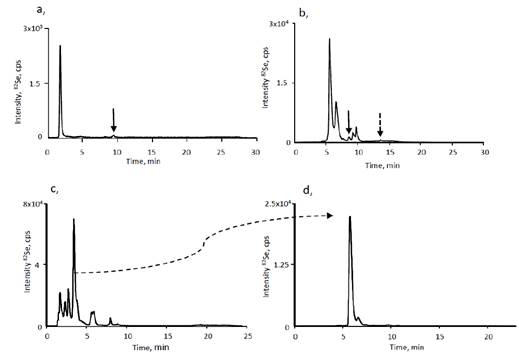超积累硒植物机理研究取得新进展
来源:《生物化学与生物物理学报》
时间:2018/03/26


硒是人和动物所必需的营养元素,但最低需求量与中毒剂量之间的范围很窄。植物是人和动物摄取硒的主要来源,国际著名生物化学家Salt认为,硒积累植物可以解决饮食硒缺乏和土壤硒过剩的医学地质问题。一方面,因为硒积累植物可用来提取人体容易吸收的有机硒,用于改善缺硒地区人群饮食硒的不足(食物硒营养强化),硒积累植物是转基因技术开发富含抗癌硒化合物农作物的基因来源;另一方面,硒积累植物是用于清除生态环境硒污染的植物修复技术的主要植物材料。因此,硒超积累植物在改善人体健康方面比其它重金属超积累植物有更大的用途和研究价值。因不同物种吸收富集硒的能力千差万别,筛选具有超常吸收、富集硒性能的硒超积累植物是成功应用硒的生物强化和植物修复的基础。
2007年,中国科学院地球化学研究所研究员邵树勋等在湖北恩施土家族苗族自治州发现我国第一个硒超积累植物碎米荠(Cardamineviolifolia)。自从碎米荠超积累植物被发现以来,碎米荠超积累植物在湖北恩施州被大规模种植开发利用,用于提取补硒食品添加剂,创造出巨大的经济效益,为当地农民脱贫致富发挥了重要作用。超积累植物吸收、富集硒的机理是开发硒生物强化及植物修复技术的理论基础,一直是国际上硒学术界研究极为关注的热点科学问题。此后,邵树勋课题组与匈牙利圣伊万斯特大学博士Mihaly Dernovics合作,利用匈牙利圣伊万斯特大学先进的HPLC-ICP-MS、LC-ESI-QTOF-MS技术方法研究碎米荠中硒的富集机理,从总硒含量达3.7g/kg的超积累硒碎米荠植物中测定出占总硒40%的硒羊毛硫氨酸(Selenolanthionine),图1、2为Selenolanthionine的SCX–ICP-MS chromatograms液相色谱图。硒超积累植物中如此高含量的有机硒化合物Selenolanthionine为国际上首次发现,取得了超积累植物通过转化贮存为Selenolanthionine的耐受硒解毒机制的新认识,为揭示碎米荠超常富集硒的机理奠定了硒代谢的理论基础。硒羊毛硫氨酸在生物制药方面有重要用途,碎米荠超积累植物富含大量硒羊毛硫氨酸的发现,为进一步开发恩施州超积累硒植物制造新型抗癌、抗菌药物提供了重要理论依据。
相关研究成果发表在Biochimica et Biophysica Acta上,研究工作得到了国家自然科学基金项目的资助。(来源:中科院地球化学研究所)
Selenolanthionine is the major water-soluble selenium compound in the selenium tolerant plant Cardamine violifolia
Abstract
Background Selenium hyperaccumulation in plants often involves the synthesis of non-proteinaceous methylated selenoamino acids serving for the elimination of excess selenium from plant metabolism to protect plant homeostasis.
Methods Our study aimed at the identification of the main selenium species of the selenium hyperaccumulator plant Cardamine violifolia (Brassicaceae) that grows in the wild in the seleniferous region of Enshi, China. A sample of this plant (3.7 g Se kg−1 d.w.) was prepared with several extraction methods and the extracted selenium species were identified and quantified with by liquid chromatography mass spectrometry set-ups.
Results The Cardamine violifolia sample did not contain in considerable amount any of the organic selenium species that are often formed in hyperaccumulator plants; the inorganic selenium content (mostly as elemental selenium) accounted only for <20% of total Se. The most abundant selenium compound, accounting for about 40% of total Se was proved to be selenolanthionine, a selenium species that has never been unambiguously identified before from any selenium containing sample. The identification process was completed with chemical synthesis too. The molar ratio of lanthionine:selenolanthionine in the water extract was ca. 1:8.
Conclusions Finding selenolanthionine as the main organic selenium species in a plant possibly unearths a new way of selenium tolerance. This article is part of a Special Issue entitled Selenium research in biochemistry and biophysics - 200 year anniversary issue, edited by Dr. Elias Arnér and Dr. Regina Brigelius-Flohe.
原文链接:https://www.sciencedirect.com/science/article/pii/S0304416518300060?via%3Dihub




